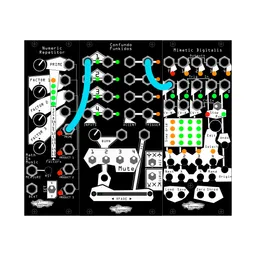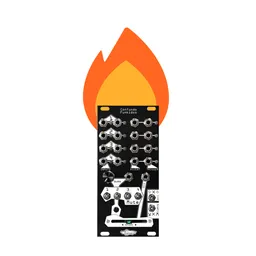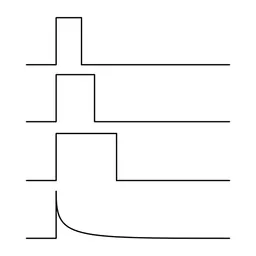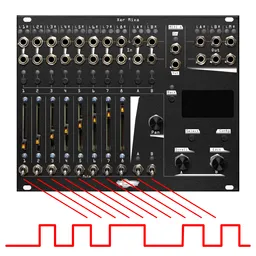Clep Diaz is a fun little modulation tool. It has a simple set of controls, but there’s quite a variety of things that you can do with it. I grew up playing classical music, so phrasing was emphasized from an early part of my musical education. It’s something that I still think about a lot today, especially while I’m patching. And wouldn’t you know it, Clep Diaz is really good for this sort of thing!
BACK UP. BROAD STROKES: WHAT IS PHRASING?
In music, phrasing is a way to give direction and structure to a musical idea using volume and timbre. If we have an eight note repeating sequence and we don’t change anything about how those notes sound, it’ll sound like it’s sitting in one spot and not going anywhere -- musically, that is.
Generally, if we’re playing an instrument, the first thing we’ll play with is volume: we’ll play a phrase so that, for instance, it gets loudest in the middle and softer towards the end. Most instruments have a change in timbre depending on how loud or how soft you play them, too.
In modular, we can manually manipulate things to change their volume and timbre and create phrasing, too. But sometimes, we want this to happen more automatically. And that’s where Clep Diaz comes in!
CLEP DIAZ SETTINGS
Clep Diaz has three different modes with a few different behaviors per mode. For this sort of thing, I like to start with step mode set to updn as the direction, as that’ll give us a CV sequence that rises and falls based on a clock input (but it’s worth trying out all the switch settings once things are patched up).
Once we’ve selected our settings, all that’s left to do is set Count to something that makes sense for our sequence; I usually do this by ear instead of setting a particular number, but either way will work. Generally, I use the Uni output of Clep Diaz, but you could use the Bi output instead, or as well: the only difference is that Uni is 0v to 5v and Bi is -5v to +5v, so it’ll depend on what your modulation destination likes at its input.
Now, let’s talk about that clock thing.
CLOCKING AND RESET
A lot of the time, I’ll clock Clep Diaz with whatever gates or triggers are sequencing my voice, instead of using a traditional actual clock signal. By simply multing that trig to the Clk jack, the CV coming out of Clep will increase or decrease each time my voice is triggered, which is often exactly what I want. Of course, you can feed a normal clock into it, too—that may be the best choice for your patch.
The Reset jack is optional: you don’t have to patch anything at all to Rst if you don’t want to, and Clep Diaz will go on its merry modulating way. However, thinking creatively about how reset can affect our resulting CV can open up some fun new possibilities.
For instance, I like to trigger Rst every time my sequence restarts, if I’m dealing with a loop. You can do this with a clock divider (for instance, if you have a 16 beat long sequence, patch a /16 to the Rst). I have some sequencers that have beginning-of-cycle triggers, so I often use those (or a spare trigger output to create one manually). The great thing about this technique is that Clep Diaz will stay in phase with your sequence, even if Count is set to a random number.

WHAT TO MODULATE?
So: We’ve set up Clep Diaz. We’ve figured out our clock and reset options. And that means we’ve created a great, musical CV signal. But what should we do with it?
Go to any input, but I’ll generally patch it to some sort of mult first, so that I can gently modulate a few things in a patch all at once. Sinc Defero is a great choice for this: it’ll make up to four copies of a signal, and then let you attenuate them individually, creating an easy-to-control modulation routing with a single module. Lapsus Os is another great choice, since its controls are so performable. Any combination of mults and attenuators will work, though.
If you want to modulate the volume of a sound with the Clep, simply run your sound through a VCA and patch the Uni out to it. This is a simple way to create crescendos and decrescendos. If your VCA has a level control, you can use that to set the minimum level of your volume swell. If it doesn’t, you can offset the CV to achieve the same result.
With traditional acoustic instruments, louder sounds will generally have brighter harmonic content than quieter ones. We may also want to route this modulation signal to something like a filter or wavefolder. The louder the signal, the more the filter will open or the more the wavefolder will fold, emulating that sort of natural response.
You could also route this modulation to something like the decay time of an envelope, making your sound ring out for different amounts of time. Or get weird and try to create sounds that are just yours! Basically, the possibilities are endless—try stuff out and see what sounds good!
GET HANDS-ON
Of course, we can also change how the modulation from Clep Diaz sounds. If you’re using the reset technique from above, you can change Count to be whatever value you want on the fly, and the modulation will stay in-phase with your sequence no matter what. You can also change the direction to up for a crescendo, or dn for a decrescendo. And you can also route other CV signals in to modulate count, making your sequence even more dynamic and varied.
And here’s another opportunity to get weird: trigger Rst at different intervals from your sequence (or manually with the button) for a bit of unpredictability. Half the fun of modular is experimenting and finding your style!





